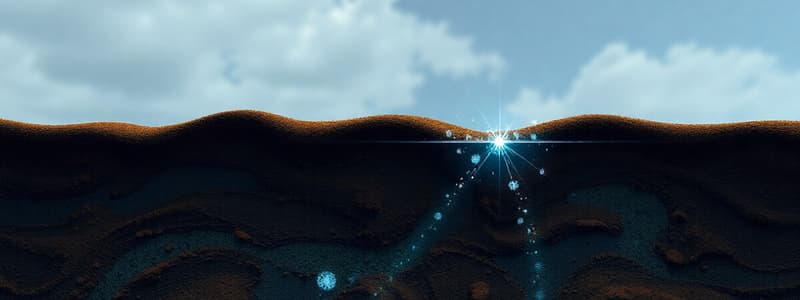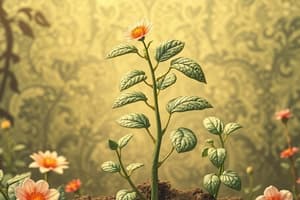Podcast
Questions and Answers
What is the primary purpose of the muslin membrane in the experiment?
What is the primary purpose of the muslin membrane in the experiment?
- To assist in the absorption of liquids
- To hold the tubes together during the experiment
- To prevent air from escaping the tubes
- To separate the contents from external contaminants (correct)
How many glass tubes are used in the described experiment?
How many glass tubes are used in the described experiment?
- One
- Four
- Three
- Two (correct)
What is stated about the ends of the glass tubes in the experiment?
What is stated about the ends of the glass tubes in the experiment?
- Both ends are closed with a membrane
- One end is closed with a membrane (correct)
- One end is closed while the other has a hole
- Both ends are open
What initial action is suggested for conducting the experiment?
What initial action is suggested for conducting the experiment?
What would likely happen if both ends of the tubes were sealed without any holes?
What would likely happen if both ends of the tubes were sealed without any holes?
What does the arrangement of dots in clay soil primarily indicate about its texture?
What does the arrangement of dots in clay soil primarily indicate about its texture?
Which of the following statements best describes soil texture?
Which of the following statements best describes soil texture?
What characteristic is NOT typically associated with clay soil?
What characteristic is NOT typically associated with clay soil?
Which type of soil would likely have the least space between particles?
Which type of soil would likely have the least space between particles?
How can the texture of soil influence its agricultural use?
How can the texture of soil influence its agricultural use?
What characteristic of clay soil contributes to its ability to retain water?
What characteristic of clay soil contributes to its ability to retain water?
Which soil type is likely to absorb water more quickly due to its physical structure?
Which soil type is likely to absorb water more quickly due to its physical structure?
How does the particle size of clay soil affect its drainage capabilities?
How does the particle size of clay soil affect its drainage capabilities?
What is a result of the high attraction force between particles in clay soil?
What is a result of the high attraction force between particles in clay soil?
What happens to water in sandy soil after a rain event?
What happens to water in sandy soil after a rain event?
What is a necessary characteristic of the line that needs to be drawn in relation to the triangle?
What is a necessary characteristic of the line that needs to be drawn in relation to the triangle?
In what way should the line relate to the triangle's sides?
In what way should the line relate to the triangle's sides?
What is the measurement specified for the head of the formed angle from the drawn component?
What is the measurement specified for the head of the formed angle from the drawn component?
Which of the following descriptions best fits the angle's head formed by the drawn line?
Which of the following descriptions best fits the angle's head formed by the drawn line?
How many sides of the triangle does the line have to be parallel to?
How many sides of the triangle does the line have to be parallel to?
Which of the following best describes the water absorption characteristics of clay soil?
Which of the following best describes the water absorption characteristics of clay soil?
What characteristic of sandy soil is highlighted by the illustration provided?
What characteristic of sandy soil is highlighted by the illustration provided?
How does clay soil compare to sandy soil in terms of water retention?
How does clay soil compare to sandy soil in terms of water retention?
What impact does the particle size in clay soil have on water movement?
What impact does the particle size in clay soil have on water movement?
Which soil type is indicated to lose water at a rapid pace?
Which soil type is indicated to lose water at a rapid pace?
Flashcards are hidden until you start studying
Study Notes
Experiment: Soil Water Absorption and Retention
- Two glass tubes are prepared, each with two holes and a muslin membrane at one end.
- Sandy soil absorbs water rapidly and loses it quickly due to weak attractions between its large particles.
- Clay soil absorbs water slowly and retains it for longer periods due to strong attractions between its small particles.
Soil Texture:
- Soil texture refers to the relative proportions of sand, silt, and clay particles within a soil sample.
Determining Soil Texture:
- A soil texture triangle is used to determine the texture of a particular soil.
- To read the triangle, a line is drawn from each of the three components (sand, silt, clay) towards the opposite side of the triangle.
- The point where the lines intersect represents the soil texture.
- Each component (sand, silt, clay) must be represented by a line that is parallel to one side of the triangle.
- The head of the formed angle (the point where the lines intersect) represents 100% of the specific component.
Studying That Suits You
Use AI to generate personalized quizzes and flashcards to suit your learning preferences.




